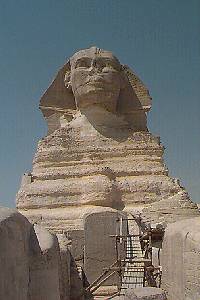
Photograph ©1998
Guardian
Ever since its rediscovery, relatively recent as it may be, theories
and controversies, have swirled around the Sphinx. Perhaps this situation
is not new, and the same occurred after previous rediscoveries, which were
also followed by feverish attempts at repair and preservation, after which
the desert once again claimed all but its enigmatic Sphinx head.
The real riddle of the Sphinx relates to its very identity. Everything that
you may have learned in school or through mainstream educational programs
is most likely erroneous. The people who have contributed to the status quo
of the now stale and challenged "accepted theory" appear to be reluctant
to accept new research. In some cases, those charged with protecting this
precious leonine treasure actually deny access to researchers with whom they
have had disagreements over theory.
Finding reliable information on just what is going on is very difficult.
When one does come across new information, s/he must wade through rumor,
supposition, and, even more unfortunately, vitriolic back-biting.
Edgar Cayce said, while in
trance: that there were hidden areas below the Sphinx and that a Hall of
Records that would be discovered near the end of this century.
Educational television programs make it as boring as possible.
Then, along came a few "new" researchers who had become faqscinated
with the Sphinx. Thank heavens John Anthony West contacted Robert
Schoch, a respected geologist, stratigrapher, and paleontologist. Professor
Schoch has presented evidence that the Sphinx has been eroded by
precipitation -- long periods of rains.
Graham Hancock and Robert Bauval took this information and combined it with
their own research and that of many others. The work that they've done, together
and individually, is much too detailed to cover on a few pages of a web site.
Their coauthored book,
The
Message of the Sphinx should be available in libraries by now. Graham
Hancock and Robert Bauval seem to be the ones to turn to for honest reports
on developments at Giza.
Almost a century ago, P.D. Ouspensky wrote about his visit to the Sphinx.
You may find that his down-to-earth yet mystical description explains a portion
of the Sphinx's magnetic attraction.
I hope you'll enjoy the reading selections and links provided below. Keep
in mind that this is not the main page of the site. To see a table of contents,
go to the main page of WOVOCA! This section will be
continually updated as I come across new information.












![[Image]](pict41.jpg)
![[Image]](pict43.jpg)